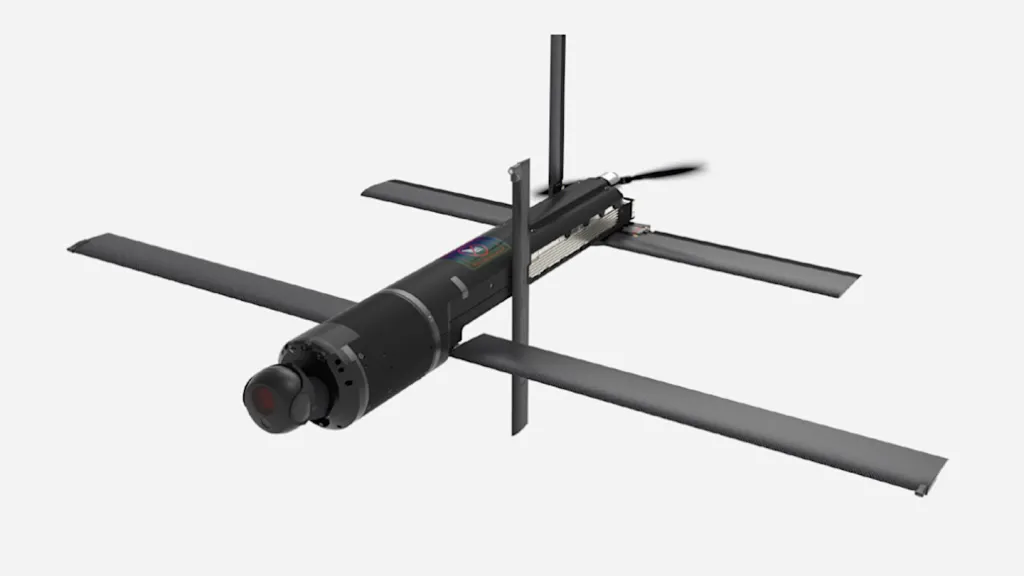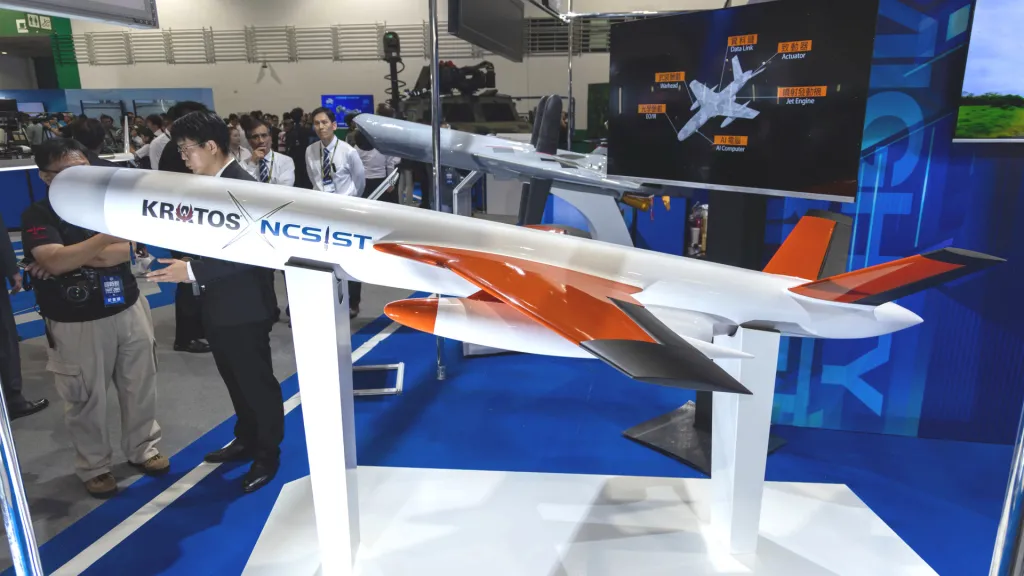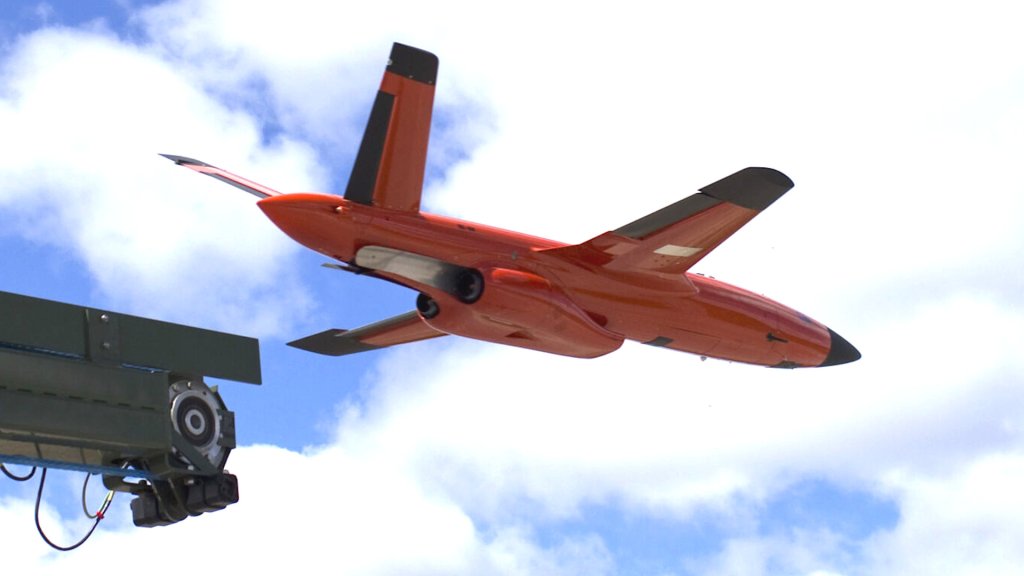Tank-Busting Switchblade 400 Joins AeroVironment’s Family Of Kamikaze Drones
AeroVironment has unveiled a new member of its Switchblade family of loitering munitions, the Switchblade 400. It is designed to offer similar capabilities, especially when it comes to destroying enemy tanks and other heavy armor, to the larger Switchblade 600, but in a package that a single individual can employ. It is also sized to fit into U.S. military standard Common Launch Tubes (CLT), which are typically used to fire precision-guided munitions and small uncrewed aerial systems from crewed and uncrewed aircraft, primarily within the special operations community.
Todd Hanning, product line director for what AeroVironment is currently calling its Mojave systems, which includes the Switchblade 400, talked about the new offering with TWZ‘s Howard Altman on the show floor at the Association of the U.S. Army’s (AUSA) main annual symposium today. The Switchblade 400 was originally developed to meet a U.S. Army requirement under the service’s Low Altitude Stalking and Strike Ordnance (LASSO) program. LASSO is also part of a larger effort that the service calls its Lethal Unmanned Systems Directed Requirement (LUS DR). The Army has already been buying Switchblade 300s, which are smaller than the new 400 version, as well as the bigger 600s, to meet its LASSO/LUS DR needs.

Hanning explained that the core Army requirement that led to the Switchblade 400 was a total weight of 40 pounds for the All-Up-Round (AUR), which consists of the loitering munition and its launch tube. AeroVironment’s website says a single individual can carry the weapon and have it ready to launch within five minutes. The Switchblade 600 is available in a man-portable form, but is designed for employment by a team and takes twice as much time to set up.
Switchblade 400 needed to be a “single soldier lift,” Hanning said. “Switchblade 600, coming in at about 67 pounds, so right out of the gate, we’ve got to shed about 30 pounds off this thing. Yet we still want the same lethality for [sic; as] a Javelin.”

The Switchblade 600 notably features an anti-armor warhead based on the one in the FGM-148 Javelin anti-tank guided missile (ATGM). AeroVironment also unveiled a Block 2 version of the Switchblade 600 today, which offers greater endurance and a new secondary payload bay for added flexibility, as well as improvements to its artificial intelligence and machine learning-driven automated target recognition capabilities.
Hanning said that the Switchblade 400 and Switchblade 600 Block 2 reflect a new modular, open-architecture approach AeroVironment is taking, which offers benefits when it comes to manufacturing and supply chains. The “same avionics, … the same camera architecture, same motor, [and] same power technology” are used in both models.
Overall, Switchblade 400 is “how do we take, really, a Block 2 [Switchblade 600], the next-gen, take 30 pounds out of it, and still do the same mission,” Hanning added. “Now you’re losing a little bit of endurance, right? We had to pull two cameras out, but you still have a gimbaled payload with probably the best optics out there on this kind of a platform, you’ve got the Javelin [warhead], you’ve got some new battery technology, and it’s very lightweight.”

AeroVironment’s website says Switchblade 400 has a maximum endurance of 35 minutes, and a speed profile that allows for 27 and 15 minutes of loiter time after reaching target areas 12.4 miles (20 kilometers) and 21.7 miles (35 kilometers) away, respectively. The company also says it can reach out to around 40 miles (65 kilometers) by handing off control to an operator closer to the target.
This all puts Switchblade 400 roughly in between current-generation Switchblade 300s and Switchblade 600s in terms of range and endurance, but with the ability to engage the same kinds of targets as the latter. Switchblade 300s have much smaller warheads weighing just under four pounds. Switchblade 400 also gives a single user a major boost in capability over a Javelin, which has a demonstrated maximum range of just under two and a half miles (4,000 meters) in its latest man-portable configuration, and no ability to loiter.

Hanning used the breadth of targets that Ukrainian forces have been using Switchblade 600s against to underscore the capabilities on offer. Ukraine has received tranches of both Switchblade 300s and 600s.
“They were shooting some tanks early on, but now you’re seeing them take out surface-to-air missile batteries constantly,” he said. “They’ve taken out some trains. A lot of command elements. But mostly what you’re seeing is those high-value assets, those mobile surface-to-air missile batteries.”
It is worth noting here that AeroVironment has been securing sales of Switchblade 300s and 600s to a growing number of countries beyond the United States and Ukraine in recent years. Last year, the U.S. government notably approved the potential sale of 720 Switchblade 300s to Taiwan. The Taiwanese armed forces have been stepping up their acquisition of a growing array of one-way attack drones as part of a larger strategy to challenge a potential intervention from the mainland, as you can read more about here.
That being said, lessons learned from the particular drone-heavy war in Ukraine have been very important for AeroVironment, according to Hanning.
“We take lessons learned from all of the systems that are in Ukraine, and rapidly inject that technology into the 400 and the 600 Block 2,” Hanning said. “So launching in different environments, on different ground surfaces, that was one. Tactics for range and for how you engage the target. So we’re engaging from higher altitudes. We’re engaging faster. We have different communication modes, silent modes, things like that.”
Hanning said the silent mode referred to here involves operating, at least for a time, without emitting signals that enemy forces could detect. He noted that members of the Switchblade family are designed around concepts of operations that involve a human at least ‘on-the-loop’ during any endgame attack run, despite their highly automated targeting capabilities.

In general terms of controlling Switchblades after launch, “we are running Silvus radio[s], but we are agnostic to radios. So we’ve also integrated an L3Harris radio. We did that about two weeks ago. Very easy,” he added. “So, we’re looking to, how can we shed weight at the soldier level so that we’re using all the common systems that they’re already carrying. So, if that’s a PRC radio that they’re already carrying, if we can leverage that for our C2 [command and control] scheme, then that’s what we’d want to do. … that’s part of that whole modular, open system architecture.”
Switchblade 400s, as well as 600s, could make use of their modularity in other ways going forward. Hanning highlighted the possibility of different warhead options by mentioning a test involving a different type supplied by a company called Corvid Technologies.
“We’re really open to whatever the DoD wants. When a lot of people come to us and say, ‘use my thing,’ and I’m like, well, what does the Army think about that?” Hanning said. “We need to know what they want versus what a vendor wants you to want. And so the best way to do that is to just be very open, hear the voice of the customer, and have the ability to integrate things.”
“When you start doing mixed payloads, you definitely want to play with some [things], maybe a smaller warhead, with some electronic warfare packages, things like that,” he continued. CACI is set to supply an electronic warfare package for testing on Switchblade 400 later this month.
AeroVironment’s emphasis on flexibility has already extended to launch modes. Launchers integrated into crewed and uncrewed armored and other ground vehicles, offering indirect fire and reconnaissance capabilities, have been put forward. The Switchblade 300, at least, has been test-launched from maritime platforms. Last month, General Atomics also announced a test launch of a Switchblade 600 from one of its MQ-9 Reaper drones.

Switchblade 400’s aforementioned ability to fit inside a CLT immediately opens up a host of additional potential launch platforms, including various crewed and uncrewed fixed-wing aircraft and helicopters. CLT-launched munitions are a particularly significant part of the current armament package on the U.S. Air Force’s AC-130J Ghostrider gunships, something they inherited from the now-retired AC-130W variants.


When it comes to the Army requirement that drove the initial development of the Switchblade 400, the service is currently evaluating four different options, according to AeroVironment’s Hanning. A downselect of some kind is expected to come in time, but it’s unclear whether the service might choose to further pursue multiple entrants.
Whether or not the Army ultimately acquires Switchblade 400s, it looks to be a significant new addition to this family of loitering munitions, which is seeing growing popularity globally.
Contact the author: [email protected]











